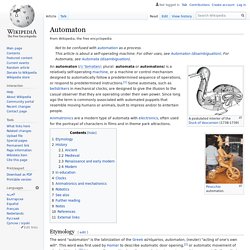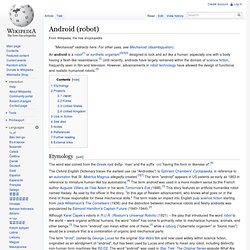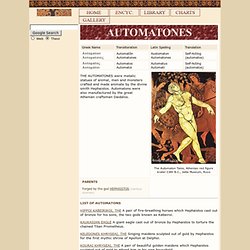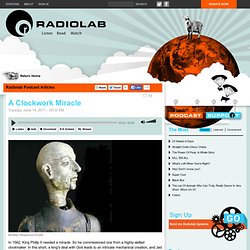

Automaton. A self-operating machine Animatronics are a modern type of automata with electronics, often used for the portrayal of characters in films and in theme park attractions.

Etymology[edit] The word "automaton" is the latinization of the Greek αὐτόματον, automaton, (neuter) "acting of one's own will". This word was first used by Homer to describe automatic door opening,[2] or automatic movement of wheeled tripods.[3] It is more often used to describe non-electronic moving machines, especially those that have been made to resemble human or animal actions, such as the jacks on old public striking clocks, or the cuckoo and any other animated figures on a cuckoo clock. History[edit] Ancient[edit] The automata in the Hellenistic world were intended as tools, toys, religious idols, or prototypes for demonstrating basic scientific principles.
The Antikythera mechanism from 150–100 BC was designed to calculate the positions of astronomical objects. The animated figures stand Adorning every public street.
Android (robot) An android is a robot[1] or synthetic organism[2][3][4] designed to look and act like a human, especially one with a body having a flesh-like resemblance.[2] Until recently, androids have largely remained within the domain of science fiction, frequently seen in film and television.

However, advancements in robot technology have allowed the design of functional and realistic humanoid robots.[5] The word was coined from the Greek root ἀνδρ- 'man' and the suffix -oid 'having the form or likeness of'.[6] The Oxford English Dictionary traces the earliest use (as "Androides") to Ephraim Chambers' Cyclopaedia, in reference to an automaton that St. Authors have used the term android in more diverse ways than robot or cyborg. Eric G. The Intelligent Robotics Lab, directed by Hiroshi Ishiguro at Osaka University, and Kokoro Co., Ltd. have demonstrated the Actroid at Expo 2005 in Aichi Prefecture, Japan. EveR-2, the first android that has the ability to sing.
AUTOMATONS : Animate statues ; Greek mythology ; pictures : AUTOMATONES. THE AUTOMATONES were metalic statues of animal, men and monsters crafted and made animate by the divine smith Hephaistos.

Automatons were also manufactured by the great Athenian craftsman Daidalos. HIPPOI KABEIRIKOI, THE A pair of fire-breathing horses which Hephaistos cast out of bronze for his sons, the two gods known as Kabeiroi. KAUKASIAN EAGLE A giant eagle cast out of bronze by Hephaistos to torture the chained Titan Prometheus. KELEDONES KHRYSEAI, THE Singing maidens sculpted out of gold by Hephaistos for the first mythic shrine of Apollon at Delphoi. KOURAI KHRYSEAI, THE A pair of beautiful golden maidens which Hephaistos sculpted out of gold to attend him in his own household. KUONES KHRYSEOS & ARGYREOS A pair of watchdogs one crafted out of gold and the other out of silver by Hephaistos for the palace of King Alkinous of the Phaiakians.
TALOS A giant sculpted out of bronze by Hephaistos and presented to Europa Queen of Krete as a wedding present. Homer, Odyssey 7. 87 (trans. AUTOMATONS trailer. Automaton figure of a monk, South Germany or Spain, c. 1560. A Clockwork Miracle. In 1562, King Philip II needed a miracle.

So he commissioned one from a highly-skilled clockmaker. In this short, a king's deal with God leads to an intricate mechanical creation, and Jad heads to the Smithsonian to investigate. When the 17-year-old crown prince of Spain, Don Carlos, fell down a set of stairs in 1562, he threw his whole country into a state of uncertainty about the future. Especially his father, King Philip II, who despite being the most powerful man in the world, was helpless in the face of his heir's terrible head wound.
Contributor Latif Nasser, a graduate student in the History of Science Department at Harvard, explains that when none of the leading remedies of the day--bleeding, blistering, purging, or drilling--helped, the king enlisted the help of a relic...the corpse of a local holy man who had died 100 years earlier.